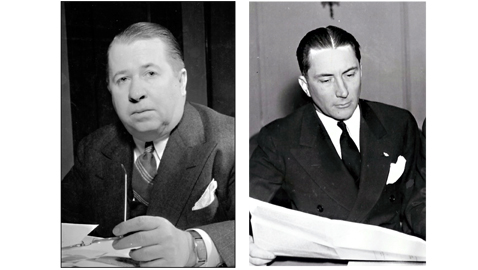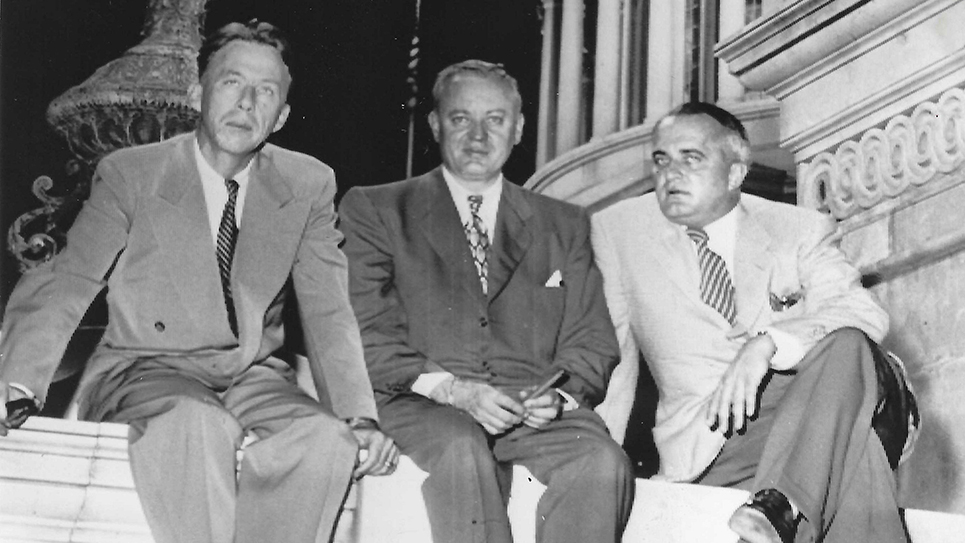It may well be quite difficult for many readers to imagine the importance of newspapers decades ago, as we now live in an age where the Internet reigns supreme and daily papers are much diminished, if not dying. The daily newspaper was one of, if not the most important, source of information for many Americans. Newspapers helped to form opinions and thoughts for millions. Newspapers were an essential part of daily American life.
In larger cities, there was almost invariably both a morning and evening edition of the newspaper and oftentimes an afternoon edition as well. Quite frequently, there were competing newspapers in the same city. For instance, at the beginning of the 1930s, Washington, D. C. had no less than five daily newspapers. It was a daily ritual for millions of Americans to breakfast on bacon and eggs and enjoy their morning coffee while catching up on the latest news. The content of newspapers and magazines at the time was substantial. To give one an idea, the print edition of TIME magazine today might be one sixth of an edition published in 1946.
Two of the most important and influential newspapers in Tennessee were located in Nashville. The Nashville Banner and the Tennessean were widely read and both papers provided extensive and lively coverage of Tennessee politics. The Banner and the Tennessean featured excellent editorials, not infrequently lambasting the other daily paper. The editorial feuds between the two Nashville papers were oftentimes highly entertaining.
The publisher of the Banner for more than forty years was James G. Stahlman; from 1937 until his death in 1955, the publisher of the Tennessean was Silliman Evans.
Silliman Evans was a diminutive and rotund man of great ambition, considerable ability and no small vision. Evans was not a native Tennessean, having been born in Joshua, Texas April 2, 1894. His father had been a traveling Methodist preacher and funds were scarce, although Silliman Evans managed to get an education, attending Polytechnic College. As a teenager, Evans worked as a printer’s assistant and found himself drawn to the newspaper business. Evans worked as a reporter for newspapers in Waco and Houston and while covering politics in the Lone Star State, he became quite familiar with many of the leading political figures in Texas. Silliman Evans became close to Congressman John Nance Garner.
“Cactus Jack” Garner was one of the more powerful members of Congress, as well as one of the most colorful. Eventually, Garner rose to become Speaker of the House. In 1932, Garner was a candidate for the Democratic presidential nomination and actually beat New York governor Franklin D. Roosevelt in the critical California primary. With the backing of the large Texas and California delegations to the Democratic National Convention, Speaker Garner was a formidable figure and one to be reckoned with. Silliman Evans joined the Garner campaign as press spokesman and publicity director. By that time, Evans had left the newspaper business and was working for Texas Air Transport, which was to become American Airlines.
John Nance Garner lost the presidential nomination to Roosevelt, but the crusty Texan was selected to be FDR’s running mate, despite the fact Garner had no desire to be vice president. It was Garner who famously described the vice presidency as not being “worth a bucket of warm piss.”
With the election of the Roosevelt – Garner ticket, Silliman Evans was rewarded with an appointment as an assistant Postmaster General, serving under James A. Farley, Roosevelt’s campaign manager, Chairman of the National Democratic Party, and FDR’s patronage mahatma.
Evans loved politics, but he loved the newspaper business even more. Evans had been looking to go back into the newspaper business and he found the opportunity he was seeking when he discovered the Nashville Tennessean for sale. Silliman Evans bought the Tennessean for $850,000 in January of 1937. The Tennessean had been owned by Colonel Luke Lea, a former United States senator and a powerhouse in Tennessee politics for decades. Lea’s publishing empire had crumbled with the onset of the Great Depression and while he desperately sought to reclaim the crown jewel of his lost domain, he was thwarted at every turn.
Silliman Evans was a shrewd businessman and proved his acumen by quickly making the Tennessean profitable within forty-five days of his taking over the management of the troubled newspaper.
Under Evans’s direction, the Tennessean quickly emerged as the voice of dissent inside the Tennessee Democratic Party. The Tennessean tortured E. H. Crump, leader of the Shelby County political machine, in print, as well as Crump’s warm personal friend and political partner, Tennessee’s senior United States senator, Kenneth D. McKellar. Evans was to become the most influential backer of both Senator Estes Kefauver and Governor Gordon Browning.
Unlike Silliman Evans, James Geddes Stahlman was born into the newspaper business. His grandfather, Colonel Edward B. Stahlman, was the owner and publisher of the Nashville Banner.
Stahlman was just a year older than his rival, having been born February 28, 1893. “Jimmy” Stahlman’s father died young, drowning in a boating accident in 1904 and the lad began working at his grandfather’s newspaper immediately following his graduation from high school. The younger Stahlman also attended and graduated from Vanderbilt University and remained fiercely loyal and protective of his alma mater throughout his life. Stahlman, the grandson of a German immigrant, fought in World War I as a private in the infantry and after returning home, he became the city editor of the Banner. In 1925, Colonel Stahlman installed his grandson as vice president and executive director of the paper. The Colonel died in 1930 and Jimmy Stahlman, at age thirty-seven, became the publisher and president of the Nashville Banner.
Stahlman was president of the Southern Newspaper Publisher’s Association in 1932 and quickly found himself at odds with another president, Franklin Delano Roosevelt. Roosevelt’s New Deal had sought to impose a federal license upon American newspapers through the National Recovery Act. Naturally, most newspaper publishers disliked the idea and more than a few thought it down right un-American, if not outright totalitarian. The publishers, under Stahlman’s leadership, fought back and won, dealing FDR a rare defeat at the height of his popularity.
Perhaps it was Jimmy Stahlman’s unpleasant experience with the New Deal that caused his newspaper to be far more conservative than its rival, the Tennessean. The feud between the two newspapers dated back generations and predated Silliman Evans. Colonel Stahlman had fallen out over politics with Luke Lea and Lea’s Tennessean had brutally assaulted the German immigrant as an “alien enemy” during World War I. Stahlman was a naturalized citizen and the enmity between the two publishers and newspapers continued throughout the years.
Not surprisingly, the Banner had strongly opposed Luke Lea’s reelection to the United States Senate in 1916, preferring to support then-Congressman K. D. McKellar instead. McKellar defeated both Lea and former governor Malcolm Patterson in the Democratic primary and Republican former governor Ben W. Hooper in the general election. The Banner would support McKellar throughout his thirty-six year tenure in the United States Senate.
Silliman Evans continued the feud with the Banner, although the two newspapers reached an agreement in 1937 that some speculate led to the eventual demise of the Banner. James Stahlman agreed to have both newspapers printed jointly; as part of the same agreement, Evans agreed to stop publication of the Tennessean’s evening edition. Stahlman, in exchange, agreed to something that was likely a far greater concession, as he stopped printing a Sunday edition of the Nashville Banner. It was a particularly significant concession for Stahlman to make, especially considering the Banner was by far the stronger paper, as the Tennessean had just come out of federal receivership.
James Stahlman and Silliman Evans were both influential in Tennessee politics and the two publishers rarely agreed on anything outside of their bargain to jointly print the two newspapers. Evans and Stahlman continued to support opposing candidates and almost never saw eye-to-eye on issues of the day.
Evans made his first real impact on Tennessee politics by supporting J. Percy Priest for Congress in 1940 against incumbent Congressman Joseph W. Byrns, Jr. Priest had actually been an employee of the Tennessean and Evans and his newspaper backed him strongly. What made Priest’s victory all the more astonishing and significant is he ran as an Independent in one of the most Democratic districts in the country. The Banner had supported Congressman Byrns.
Flush with the victory of Percy Priest, Silliman Evans broke with Governor Prentice Cooper over the repeal of the poll tax and directly challenged Crump. The Tennessean declared, “The issue is the people vs. Crump.”
Never shy about confrontation, but remarkably thin skinned for a politician, the Memphis Boss howled and demanded equal time in the pages of the Tennessean, a request Evans granted. Crump’s reply was printed on the front page of the Tennessean and the Memphis Boss blistered the publisher and promised, “Of course we have no newspaper through whose columns we could reply, but next year when our friends go over the state we will give you and your newspaper plenty to think about.
“Since Jo Byrns, the chosen Democratic nominee for Congress was defeated, you are all swelled up on yourself and you propose now to bullwhip and blackguard everybody who doesn’t look your way,” Crump said.
The war of words between the Memphis Boss and Silliman Evans would continue for the next fourteen years. Crump would alternately be outraged and amused by his exchanges with “Silly-man Evans”.
Both James G. Stahlman and Silliman Evans were deeply involved in the social life of Nashville, as well as part of the fabric of the Nashville community. James Stahlman was an avid supporter of Vanderbilt University and served on the Board of Trustees from 1927 until his death in 1976. In fact, Stahlman died from a stroke he suffered while attending a meeting of the Vanderbilt Board of Trustees.
Both newspapers took on something of the personalities of the men who ran them; the Banner supported business and the business community. The Tennessean, like its flamboyant and brash owner, was much more likely to back a lost cause. Evans was a dedicated supporter of the national Democratic Party, Franklin Roosevelt and the New Deal. The Banner was certainly not hidebound to the Democratic Party and would support Republican candidates nationally. The Tennessean editorials liked to assert the Banner was a Republican paper.
The Banner was at the peak of its influence during the days when Tennessee politics was dominated almost completely by the political alliance between Senator K. D. McKellar and Boss Crump. Silliam Evans truly came into his own with the 1948 election of Estes Kefauver to the United States Senate. Evans was one of the first people Kefauver consulted about a possible Senate bid and the publisher gave him solid backing throughout the campaign. Yet, ironically, it was E. H. Crump himself who made it possible for Kefauver to win when the Memphis Boss refused to support incumbent senator Tom Stewart for reelection. Crump threw his support to Judge John A. Mitchell, an obscure figure from Cookeville. Evidently Crump had never expected Stewart to stay in the race, making it a three-way contest between the incumbent, Congressman Kefauver and Judge Mitchell. Kefauver won with only a plurality of the vote and had Crump decided to back Senator Stewart, he would almost surely have won.
Kefauver’s victory was sweetened by that of Gordon Browning, who had defeated Governor Jim Nance McCord for reelection that same year. McCord had instituted a sales tax for education, which was highly unpopular with Tennesseans, despite providing free textbooks for school children. Ten years earlier, Browning had left the governor’s mansion largely discredited and disgraced. The election of Browning and Kefauver gave Silliman Evans new prestige and began a new era in Tennessee politics.
That cycle was completed in 1952 when two rising political stars flashed across the sky. Congressman Albert Gore defeated an aging and ailing Senator McKellar and Frank Clement beat Governor Gordon Browning. The influence of the two Nashville newspapers was split right down the middle that year. The Tennessean supported Gore and Browning, while the Banner backed McKellar and Clement.
With McKellar’s defeat and Crump’s influence outside of Shelby County negligible, Silliman Evans’s goal had been achieved. The Tennessean would go on to bedevil Governor Frank Clement; few who saw the editorial cartoons of the governor clothed in a suit of dollar signs could forget them.
Yet things were changing for both Silliman Evans and James Stahlman as well. Evans was suffering from a serious heart ailment and was under the care of a physician when he left Tennessee to attend the funeral of Amon Carter, a close friend and Texas newspaper publisher. The friendship between the two men was so close that Evans had named one of his sons Amon Carter Evans. The publisher had been warned by his doctor not to go and proved to be right, as Silliman Evans suffered a fatal heart attack while in Fort Worth. Evans was found in his room at the Fort Worth Club before 8:00 a.m. on June 26, 1955, lying on his bed, dead. It was believed the Tennessean publisher had been dead for sometime before his body was discovered. Silliman Evans was sixty-one years old.
James G. Stahlman would outlive his rival by more than twenty years. Stahlman married three times, divorcing his first wife and remarrying in 1939. Stahlman’s second wife died in an automobile accident and the publisher remarried yet again, a union that lasted until his own death in 1976.
Before dying, Stahlman funded five endowments at Vanderbilt University in honor of his father, mother, wife, and two daughters. It was also James Stahlman who finally ended his family’s long hold on the Nashville Banner. Stahlman had been the sole owner of the paper since he bought out the shares owned by an uncle in 1955. He sold the paper to the Gannet Company in 1972. The Banner would close its doors and stop its presses in 1992.
The death of any great newspaper is truly a sad event and the demise of the Nashville Banner was also the death of a proud tradition in Tennessee history.
The Tennessean still thrives today, as much as any daily newspaper in America can be said to thrive today. The Stahlman Building still stands in Nashville and perhaps the spirits of both Silliman Evans and James G. Stahlman linger nearby.







